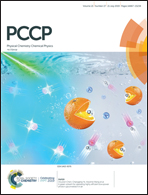The reaction mechanism of Zika virus NS2B/NS3 serine protease inhibition by dipeptidyl aldehyde: a QM/MM study†
Abstract
Zika virus (ZIKV) infection has become a global public health problem, associated with microcephaly in newborns and Guillain–Barré syndrome in adults. Currently, there are no commercially available anti-ZIKV drugs. The viral protease NS2B/NS3, which is involved in viral replication and maturation, is a potential drug target. Peptidomimetic aldehyde inhibitors bind covalently to the catalytic S135 of the NS3 protease. Here, we apply hybrid quantum mechanics/molecular mechanics (QM/MM) free-energy simulations at the PDDG-PM3/ff14SB level to investigate the inhibition mechanism of the ZIKV protease by a dipeptidyl aldehyde inhibitor (acyl-KR-aldehyde). The results show that proton transfer from the catalytic S135 to H51 occurs in concert with nucleophilic addition on the aldehyde warhead by S135. The anionic covalent complex between the dipeptidyl aldehyde and the ZIKV protease is analogous to the tetrahedral intermediate for substrate hydrolysis. Spontaneous protonation by H51 forms the hemiacetal. In addition, we use correlated ab initio QM/MM potential energy path calculations at levels up to LCCSD(T)/(aug)-cc-pVTZ to obtain accurate potential energy profiles of the reaction, which also support a concerted mechanism. These results provide detailed insight into the mechanism of ZIKV protease inhibition by a peptidyl aldehyde inhibitor, which will guide in the design of inhibitors.



 Please wait while we load your content...
Please wait while we load your content...